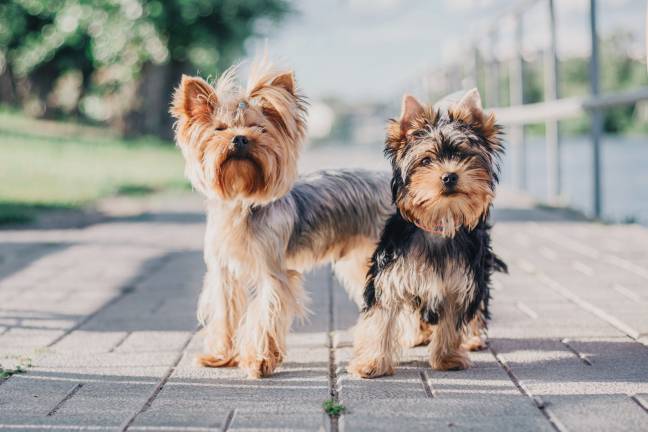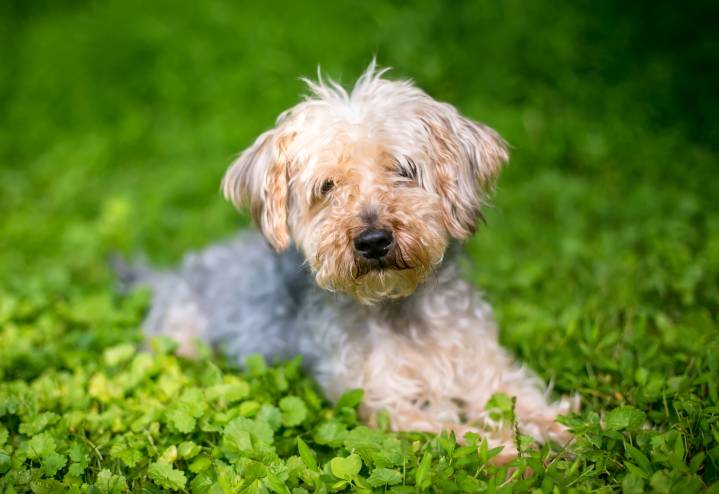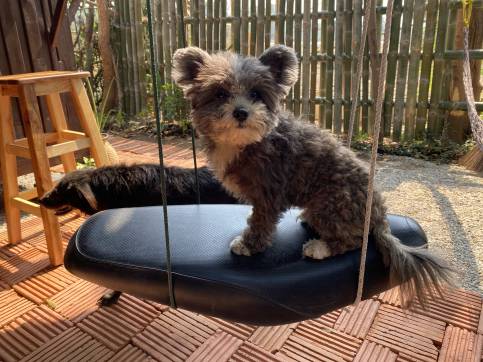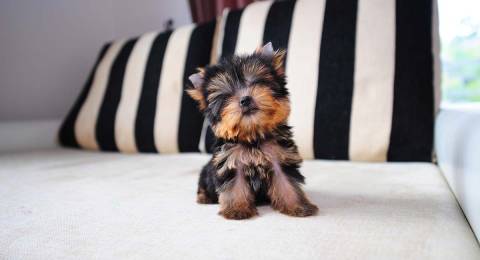Connect with a verified veterinarian in minutes. Licensed vets are available 24/7 to answer your questions. No need to worry about your furry family member.
Yorkies are one of the cutest dog breeds around! These dogs, with their glamorous long hair, may be small, but they have very big personalities!
Would you like to learn more about Yorkies and their hair colors? If so, you’ve come to the right place! We’ve put together information about the Yorkie dog breed and then dive into their fur colors. Let’s get started!
What is a Yorkie?
Yorkies, properly called Yorkshire Terriers, are pretty dogs that believe they’re big dogs. These dogs are extremely confident. And why shouldn’t they be? They’re beautiful! Yorkies have long flowing, silky hair that gives them a glamorous look! They’re also very intelligent!
When it comes to personality, Yorkies have it! They’re always looking for their next adventure and conquest, though they’re small dogs. These dogs believe they’re the size of a Great Dane or larger! So, watch out when there’s a Yorkie around! They can get into a lot of trouble.
These small dogs love their families. They’re very affectionate with their loved ones and make wonderful companion dogs. However, they are wary of strangers and will bark at them. The dogs also bark at sounds, even when there’s not much to bark about!
Because Yorkies believe they’re big dogs, they tend to be more aggressive toward other dogs. And they may also go after small animals and cats, too.
Even with all this toughness, Yorkies want plenty of attention and time with their family. If these dogs are left alone too long, they may develop separation anxiety.
Are these dogs good with kids? Well, we’d have to say that Yorkshire Terriers are a good fit for older kids. The kids should be taught how to interact with the dog properly. Younger kids are not able to learn this yet. Yorkies may become snappish or irritated with small kids who try to tease them or startle them.
While these small dogs are energetic, they can nicely live in a small home or apartment. It’s important to ensure they get plenty of exercise every day to wear off all that energy.
These dogs are small—they stand between 8 to 9 inches tall and weigh between 4 to 7 lbs. They have a life expectancy of 13 to 14 years.
Quick Overview of Yorkie History
The Yorkshire Terrier was first developed in about 1861 and was called a “broken-haired Scotch Terrier.” The dog’s name was Huddersfield Ben, and he was born in 1965. He soon became a popular show dog and is considered the father of modern Yorkies!
Since that time, Yorkies have become a favorite all over the UK, US, and Europe.
OK, now we’re ready to get down to the Yorkie fur colors!

Review symptoms, medications & behavior to keep your pets healthy with a Vet Online in just minutes.
Ask a Vet Live NowYorkie Color Genetics
The Yorkie’s famous colors and fur are all determined by the dog’s genetics. Yorkies have two primary colors: eumelanin (black) and phaeomelanin (red) that create the traditional colors of a Yorkie. The precise color of an individual dog is determined by the number of graying genes the dog has.
The graying genes have an effect on the dog’s melanin levels and can lead the coat color to face. Here, black turns into blue and tan to gold. It’s really interesting!
The eumelanin pigment recedes in some parts of the Yorkie’s body as the puppy grows up. The color is then replaced by the phaeomelanin pigment.
Then there is something called the recessive piebald gene, which some dogs inherit. This causes the white color in Yorkies, though this is pretty rare.
Traditional Yorkie Colors
The traditional Yorkie colors are quite distinctive and make it easy for everyone to recognize these amazing little dogs. The puppies are born black and tan, which then changes over to blue and gold as they grow. However, it’s also possible for Yorkies to have other color combinations.
Yorkies have four traditional colors, including:
- Black
- Blue
- Tan
- Gold
Yorkie puppies usually begin changing color when they’re about six months old. The process is gradual, and some pet parents may not even notice!
Yorkie Adult Colors & Markings
The AKC recognizes about five different color combinations in Yorkies:
- Blue and tan
- Black and gold
- Blue and tan
- Blue and gold
- Parti colored (black, white, and tan)
Yorkies don’t change over to their adult colors until they’re about two to three years old. As they change from puppy to adult, there’s more tan and gold than blue or black. So, adults have a much lighter coat than the puppies.
Golden Yorkies
These dogs have a unique look compared to other Yorkies. They have gold hair on their breast, belly, and head that’s a gold color. However, there should be no blue mixed with the gold. Their legs may also be a gold color up to their elbows and knees.
In addition, Golden Yorkies may have a blue color that goes from their neck to the base of their tail, with no tan or gold. The tail is a darker shade of blue than the rest of the dog’s body.
These dogs are not called Blonde Yorkies—they are Gold Yorkies. They’re unique and beautiful dogs!
Blue Yorkie Puppies
Then there are Yorkie puppies who are blue! These aren’t small Smurfs, though they would be pretty cute! The blue Yorkie starts out blue at birth, which is caused by two copies of a recessive gene.
The downside is that these puppies don’t survive long due to their genetics. They don’t live much beyond a year old. The ones who do make it to one year begin to lose their fur rather than turning black.
These poor dogs end up in much pain and are usually put down. It is possible for some blue puppies to have a normal, healthy life, but they are prone to skin problems and allergies.
When searching for a Yorkie fur baby, be sure to stay away from breeders who sell blue Yorkie puppies.
Teacup Yorkie Colors
First, we have to let you know that there’s also a teacup version in addition to the normal-sized Yorkie! Teacup Yorkies are not a separate breed; they’re just a smaller version of the Yorkshire Terrier. They stand between 5-7 inches tall and weigh between 2-4 lbs. Their life expectancy is about 12 years.
While these dogs are adorable, these small dogs come with a wide range of health issues. So, it’s best not to get one.
When it comes to colors, Teacup Yorkies have the same color variations as their larger cousins.
Parti Yorkies
Parti Yorkies are a unique color combination, which includes blue, tan, and white. This rare color combination is caused by a recessive gene that’s extremely rare.
No one is really sure where the gene came from. Some speculate other dog breeds were once introduced into the Yorkie bloodline. Some believe a white Maltese was cross with a Yorkie. This cross resulted in Yorkies that carried the white recessive gene. In addition, there are also blonde parti color and chocolate parti color Yorkies
Tricolored Yorkies became popular for a time; however, breeders now won’t accept these colors as purebred. However, the AKC (in 2000) recognized the parti Yorki. Even so, these dogs are considered “low quality” and usually killed or given away to owners who don’t mind their origin.
While some believe the colors are new, they’ve been around since the 1800s. Most people are not familiar with these parti colors because they are so rare.
What’s interesting is that the parti gene may not pop up very often. It can stay hidden for many generations! Parti colored Yorkies have nothing wrong with them. They’ve only inherited some rare genes that make them a different color than the traditional Yorkie.
Black Yorkie
If you see a solid black Yorkie, this is a crossbred dog, not a purebred. It’s impossible to have a completely black Yorkie. A solid black Yorkie has to carry the dominant gene for blackness. Yorkies with this gene usually have some issues:
Rigid hair: the hair stays short rather than long and has a rough texture
Dull hair: the hair may be dull and thick, with the coat growing at a faster than normal rate.
People looking for a solid black Yorkie may find a black puppy; however, the puppy won’t stay black if it’s a purebred dog.
Chocolate Yorkie
Then there are the chocolate Yorkies! These dogs are born completely brown! No one is sure how the chocolate color developed in Yorkies. There’s one theory that says the recessive gene may have come from crossing the Yorkie with a Dachshund.
Chocolate Yorkies are recognized by the AKC as chocolate/tan or liver/tan. However, they’re not allowed to show. These dogs are completely healthy and don’t have health or behavioral problems.
Red Yorkie
There are also what’s called the red Yorkie. These dogs are not completely red; instead, they have red legs. The gene for this coloring may not show up for five generations! Red-legged Yorkies are born to parents who carry two copies of a particular recessive gene.
The red Yorkie doesn’t meet the AKC standards for this breed, and they’re not allowed to show. However, the dogs are purebred and can be registered.
Are Rare-Colored Yorkies OK?
It is possible for Yorkies to come in a variety of colors; however, some weird or very rare color combinations are usually a sign the dog is not a purebred Yorkie. This isn’t always the case, of course. And if you don’t plan on registering the dog, then their color might not make a difference.
Do Yorkie Colors Affect Behavior?
Yorkies that come in the four traditional colors all have the same feisty personality of a traditional Yorkshire Terrier. They are a big dog in a small dog’s body!
However, Yorkies of other colors may not be purebreds. They could be the result of crossbreeding, which may lead to different characteristics, behaviors, and personalities. It depends on the dog’s genes.
How to Take Care of a Yorkie’s Coat
Yorkies have beautiful silky coats, and it’s important to take good care of their hair. Thankfully, Yorkies don’t shed their hair. These dogs can be a great choice for pet parents who have dog allergies. However, do know that dogs cannot be hypoallergenic. There’s no such thing.
Back to the Yorkies coat, it’s essential to brush their hair every day. Brushing removes tangles and snarls and keeps the hair shiny. Yorkies may also need a trim every so often and may need to visit the groomer about every four to six weeks.
Bathing Your Yorkie
Yorkies also need to be bathed on a regular basis, and there are some steps to follow to keep your fur baby’s hair shiny and clean!
- Brush out the knots and tangles.
- Dampen the dog’s hair before applying the shampoo. Be sure to use lukewarm water to bathe your fur baby and cover all the hair with shampoo.
- Carefully rinse out the shampoo. At this stage, your Yorkie will look more like a drowned rat! But don’t despair! After they’re rinsed and dried, Yorkies become glamorous once again!
- Condition your Yorkie’s hair. This helps to work out the tangles after your dog’s bath. It also conditions the hair and helps moisturize the skin at the same time.
- Rinse out the conditioner, and then dry your Yorkie’s hair thoroughly.
Congrats—you now have a clean, beautiful Yorkie!
Summing It Up
Yorkies come in a range of colors that are standard, but there are other Yorkies that come in more rare colors. These dogs with the rare colors are more challenging to find because they don’t fit the breed standard set by the AKC. For this reason, breeders focus on the colors that are standard for Yorkies.
However, there are some colors that are unusual and still produce healthy, purebred Yorkshire Terriers. There’s nothing wrong with these dogs. And as long as you don’t want to register, breed, or show them, you will have a beautiful, rare-colored fur baby to enjoy!
If you’re looking for a rare colored Yorkie, be sure to only choose a reputable breeder!
Connect with a verified veterinarian in minutes. Licensed vets are available 24/7 to answer your questions. No need to worry about your furry family member.

Tom
Tom has always loved to write since he was little - he wanted to be either a writer or a veterinary doctor, but he ended up being a professional writer while most of his works are based on animals. He was born in San Francisco but later moved to Texas to continue his job as a writer. He graduated from the University of San Francisco where he studied biotechnology. He is happily married and a soon to be father!
Review symptoms, medications & behavior to keep your pets healthy with a Vet Online in just minutes.
Ask a Vet Live Now




